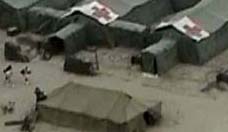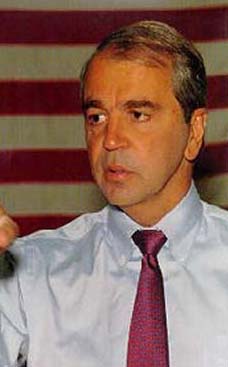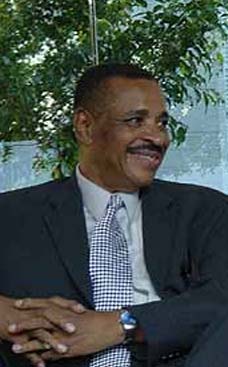
The friends tapped into a common passion for collecting fossils during their Peace Corps days and have scoured the West Coast for remains for the past 10 years. Central Oregon has become like a favorite fishing hole for the friends, where they camp and look for ammonites, an ancient mollusk. The area also has large tracts of public land where Kelly and Kovalchuk could legally search.
RPCVs Greg Kovalchuk and Mike Kelly developed a common passion for collecting fossils during their Peace Corps days
Dinosaur discovery
Published: August 8, 2005
By Ernestine Bousquet
The Bulletin
Caption: Dr. James E. Martin works carefully to remove rock from a portion of the plesiosaur fossil as co-disconverers Greg Kovalchuk and Mike Kelly look on. Photo: John Craig
Eyes pinned to the ground, fossil hunters Greg Kovalchuk and Mike Kelly were searching Central Oregon's dusty crevices for mollusk fossils late last summer when Kelly saw it.
On a spot on Bureau of Land Management land near Prineville was a jagged rock marked with a white triangle. Kelly instantly knew it was a tooth. Nearby, he found a black and bone-colored cone-shaped tooth with striations and enamel.
Twenty feet away on a slope, Kovalchuk spotted a piece of jawbone sticking out of the dirt.
The earth was spilling 100 million-year-old secrets from a time when dinosaurs prowled on land and reptiles slithered in and out of oceans.
The self-trained paleontologists found what is believed to be the first remains of a marine reptile called the plesiosaur that has been found in the Pacific Northwest.
It is also thought to be only the third vertebrate fossil uncovered in the area so far from a rock formation that dates back to the Cretaceous period, the last of the three periods of the Dinosaur Age.
What started as an annual fossil hunting and camping trip for Kelly, a California fisheries biologist, and Kovalchuk, a fisheries biologist who lives in The Dalles, ended with the discovery of another prehistoric portal to the Northwest's origins.
When South Dakota paleontologist James Martin excavated the site in May on behalf of the BLM, he found at least two nearly complete teeth, tooth fragments and a 3-foot-long lower jawbone of a 90 to 100 million-year-old plesiosaur. The pieces may constitute 80 percent of its lower jaw.
Martin thinks it was from a large-headed, short-necked plesiosaur that was 25 feet long from head to tail.
Plesiosaurs ruled the oceans during the Dinosaur Age, or Mesozoic era, which lasted from roughly 251 million years to 65 million years ago, according to Wikipedia, an online encyclopedia.
With serpentine necks, jagged teeth and flipper limbs, the elephant-sized plesiosaurs paddled in the open water just below the ocean surface, feasting on fish and prehistoric squid and mollusks.
Plesiosaurs thrived to become the largest aquatic animal at the time, before disappearing with the dinosaurs.
The marine reptiles have now become the stuff of legends — present-day fodder for Loch Ness monster myths.
Ten years ago, Martin, a marine reptile expert, started looking for plesiosaur remains in the same area where Kelly and Kovalchuk found their fossil.
After several years of searching, he came up empty-handed.
"I had given up seeing one in my lifetime," said Martin, a professor and Curator of Vertebrate Paleontology of the Museum of Geology in South Dakota School of Mines and Technology. "This is dandy. It may not be the prettiest or the most complete, but it's definitely the first."
A rare find
Finding a plesiosaur in Central Oregon was a discovery waiting to happen, said William Orr, a retired University of Oregon geologist who specializes in paleontology.
"I was delighted to hear about it, but not stunned," said Orr, who has co-written books on Northwest geography and fossils with his geologist wife, Elizabeth Orr. He is also the curator of the Thomas Condon State Museum of Fossils.
"We knew that we had roughly the right age of rock and the right environments. We just haven't found them because we hadn't bothered to look for them."
While the odds that Kelly and Kovalchuk found the plesiosaur remains are rare, the fossil collectors have schooled themselves on geology and paleontology and could instantly sort rock from relic.
"If you go enough and look for things, you realize that eventually there is a chance you are going to find something," Kelly said. "It's like a golfer who finally hits a hole in one."
The friends tapped into a common passion for collecting fossils during their Peace Corps days and have scoured the West Coast for remains for the past 10 years.
Central Oregon has become like a favorite fishing hole for the friends, where they camp and look for ammonites, an ancient mollusk. The area also has large tracts of public land where Kelly and Kovalchuk could legally search.
Known for its Cretacous rock, the region is a rich hunting ground for ancient marine life.
That is because Central Oregon has chunks of exposed older ocean floor, said Mark Ferns, a regional geologist with the Oregon Department of Geology and Mineral Industries,
Orr, the retired University of Oregon geologist, said the High Desert climate also makes the area an ideal fossil graveyard.
"The rocks don't decompose as fast," Orr said. "It creates better conditions for preserving fossils."
An ancient
puzzle piece
Kelly and Kovalchuk knew they had stumbled upon the relic of an ancient marine animal last summer.
The two men left the evidence intact and plotted the location coordinates into a GPS unit, with the intention of alerting BLM officials to the site. They also took pictures of the fossil pieces to prove their existence.
Eight months passed before they came back to the site with John Zancanella, the BLM's paleontology coordinator for Oregon and Washington and other BLM officials, for confirmation.
Zancanella knew Martin, the marine reptile expert, and sought his help. In May, Martin and assistants spent four days excavating the Central Oregon site.
After Martin examined the fossil up close, he high-fived the men. He believes they discovered a relatively rare type of plesiosaur that could shed light on a little-known period of the marine reptile's existence.
Starting with first remains uncovered in England in the 1820s, plesiosaur fossils have been found throughout the world on every continent, according to Wikipedia.
But most of them originated from the same two timeframes in the Mesozoic era, making it hard to guess how the plesiosaur evolved throughout the entire era, the encyclopedia said.
Kelly and Kovalchuk's specimen comes from a different point in the Mesozoic era and could help fill in the timeline.
It could also provide more information about the different species of plesiosaur.
So far, paleontologists have identified four main groups, or families, of plesiosaurs through fossils, according to Wikipedia.
The four groups ranged in size and were either the small-headed and long-necked variety or the large-headed, squat-necked stock that Kelly and Kovalchuk found.
"It's good because we can compare and figure out what species it is," Martin said. "It will also tell us about the oceans and the migration and dispersion of animals that occurred."
Kelly and Kovalchuk's fossil may help decode geographic mysteries by showing whether the reptile migrated here or was homegrown in the Northwest.
Depending on the answer, scientists may have more clues as to whether the Northwest was its own bio-geographic region at the time, or part of a larger basin, Martin said.
"We were looking for the story of the marine reptile on the western side of the ancestral Rockies without great success," Martin said. "The living Northwest was a blank paper and now we can finally write a chapter."
Back then
When plesiosaurs existed, most of Oregon was underwater and the shoreline was about 350 miles farther east somewhere near John Day, geologists say.
At the start of the Mesozoic era, landmass was fused into one super-continent, according to Wikipedia. But during the roughly 185 million-year era, land broke up into the seeds of the seven present-day continents.
Because of continental drifts, Oregon was a tropical hotspot near the equator at that time, said Orr, the retired University of Oregon geologist.
Plesiosaurs evolved from the lizard-like nothosaurs that crawled in and out of oceans, according to "The Fossil Book," by Patricia Rich, Thomas Rich, Mildred Fenton and Carroll Fenton.
The plesiosaur, which means "near lizard," went a step further, fully adapting to the open ocean, the authors said.
Using their four flippers like paddles — a unique design not found in modern animals — plesiosaurs became good swimmers and covered a lot of territory.
"They flew through the water like penguins," said Martin, the marine reptile expert.
The shorter-necked plesiosaurs probably ran down their prey, Martin said, while the longer-necked ones may have used their sinewy necks to ambush schools of fish.
Their blade-like teeth would tear bony fish, the striations making it easy for them to hold onto slippery fish.
Paleontologists don't know yet if they traveled in schools or alone, what their average life span was, or if they laid eggs or gave birth, Martin said.
"They had a lot of time to adapt and they had some pretty complicated behaviors," Martin said.
No one can say yet what happened to Kelly and Kovalchuk's plesiosaur.
But the fact that Martin only found a jaw is a good indication that it died elsewhere.
Sharks and other marine creatures likely scavenged the rest of the skeleton. The jawbone probably survived because it is sturdier, he said.
While he hasn't pinpointed the plesiosaur's age, he believes it was a young adult.
The specimen is now in South Dakota, where technicians have already started sorting bone and rock from teeth fragments. Martin said it will probably take at least a year to prepare the specimen and figure out how many pieces were recovered.
Zancanella, the BLM paleontology coordinator, is trying to get funding for casts of the jawbone so it can be displayed locally.
The original will be housed in South Dakota because the geology museum has the expertise and the facilities to properly care for the fossil.
With the specimen in South Dakota, Martin is ready to reconstruct another piece of prehistoric history.
"I think we all have a unique wonderment about what the past is like. There is also a curiosity about what happened to these guys. They were successful. Why all the sudden is he gone? Those questions have a direct bearing on us."
Ernestine Bousquet can be reached at 541-504-2336 or at ebousquet@bendbulletin.com.











